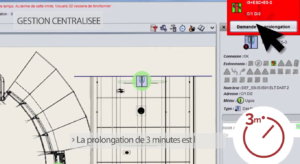CENTRALIZED MANAGEMENT OF EMERGENCY EXITS
What is a UGCIS?
A UGCIS (Centralised Emergency Exit Management Unit) enables centralised management of emergency exits by controlling exit requests via the exits by removing any doubt before the door is released.
Doors are kept locked by operated safety devices (DAS). These are managed from the Centralised Emergency Exit Management Unit (UGCIS) via an Opening Request Device (DDO) located near the exit concerned. The DDO must inform the user by an audible and visual signal that the request has been accepted.
Emergency unlocking of these exits is possible in three ways:
-Either by activating the manual emergency command for the zone concerned from the UGCIS;
-Or by automatically activating all the exits in the zone concerned via the general evacuation system located upstream;
-Or by a local action on the DDO, placed near the exit in question and resulting in the unlocking of the DAS after a time delay of 8 seconds (T1).

During the T1 time delay, the staff at the central security station can, by acting on the central part of the UGCIS, ensure that locking is maintained during a T2 time delay.

If no action is taken, the door in question is unlocked when the T1 time delay expires. Time delays can only be managed if the security personnel have a direct view of the emergency exit, or if they are assisted by a video protection system. When the T2 time delay expires, the exit in question is unlocked. The T2 time delay can be cancelled by acting on the central unit, which immediately unlocks the emergency exit. During these time delays, any alarm zone can still be made safe.

